Operations and Project Management: Sainsbury and Sunshine Report
VerifiedAdded on 2020/10/05
|19
|4874
|61
Report
AI Summary
This report delves into the intricacies of operations and project management, using Sainsbury and Sunshine Drinks as case studies. It begins with an introduction to operations management principles, followed by a critical review of their implementation within an organizational context. The report then proposes a continuous improvement plan, leveraging methodologies like Lean principles and the PDCA cycle. Further, the report analyzes the application of the Project Life Cycle (PLC), including the creation of essential supporting documentation such as a business case, target market analysis, and project plans. The final sections critique the effectiveness of the PLC, using relevant theories and models to evaluate its application to the chosen project. The report concludes with recommendations for improved operational efficiency and project success.
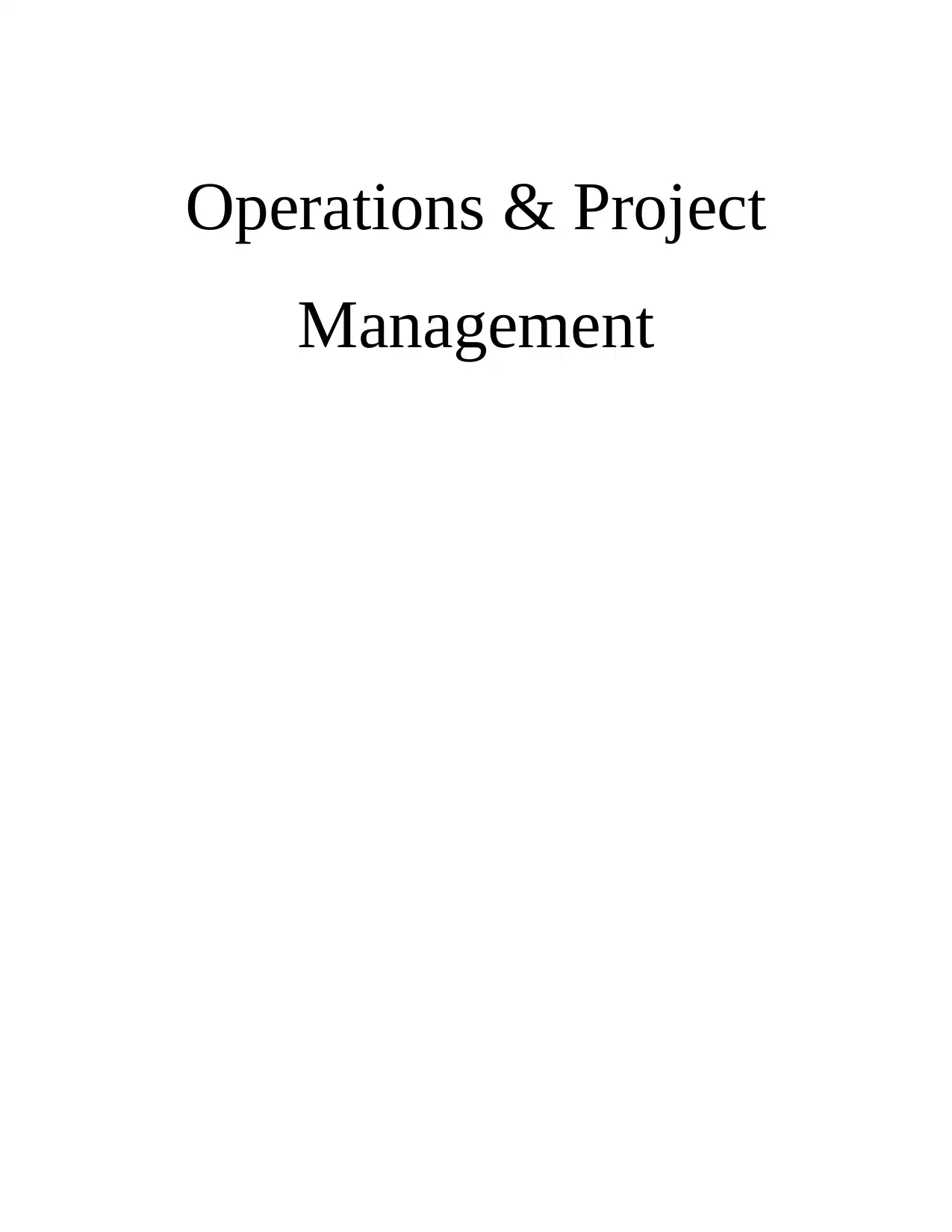
Operations & Project
Management
Management
Paraphrase This Document
Need a fresh take? Get an instant paraphrase of this document with our AI Paraphraser
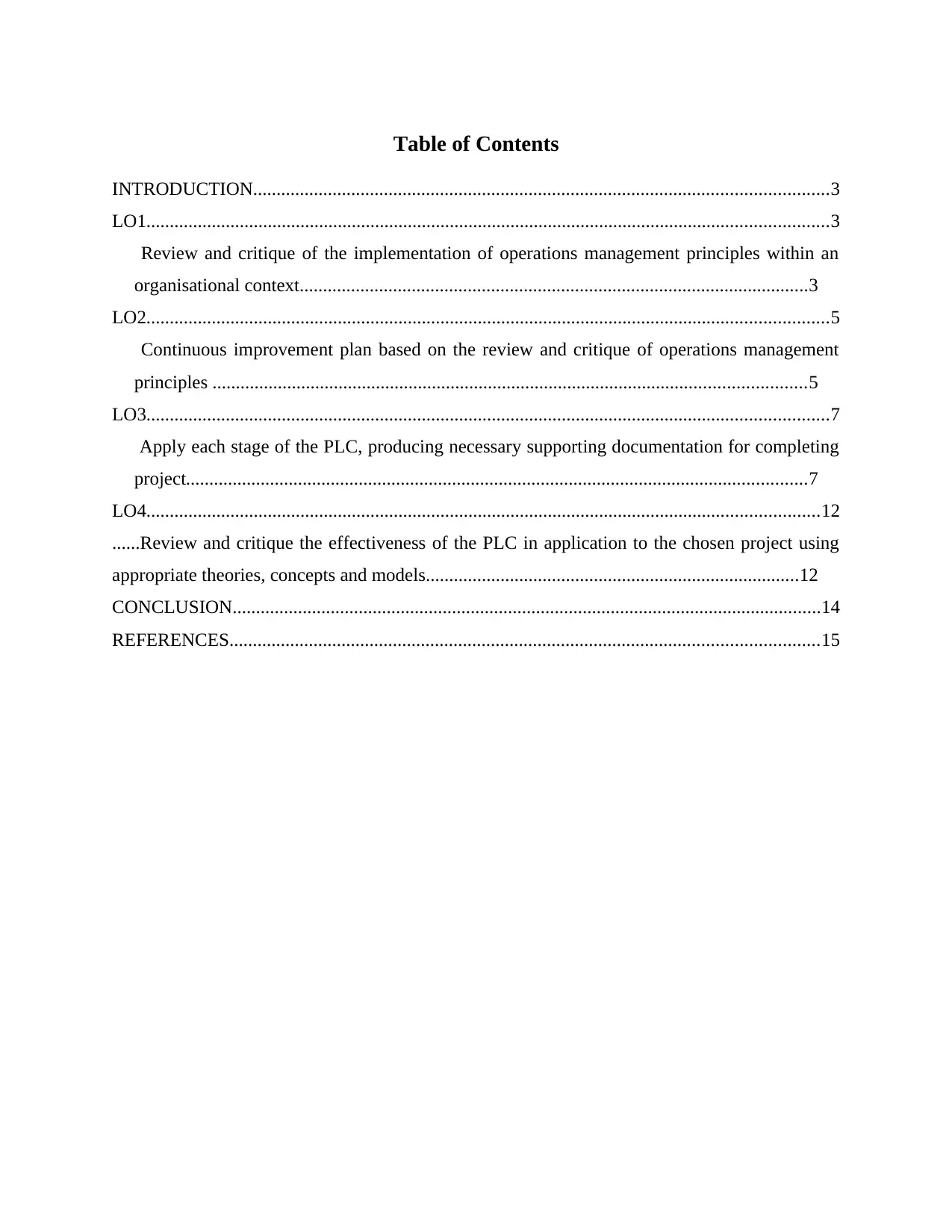
Table of Contents
INTRODUCTION...........................................................................................................................3
LO1..................................................................................................................................................3
Review and critique of the implementation of operations management principles within an
organisational context.............................................................................................................3
LO2..................................................................................................................................................5
Continuous improvement plan based on the review and critique of operations management
principles ...............................................................................................................................5
LO3..................................................................................................................................................7
Apply each stage of the PLC, producing necessary supporting documentation for completing
project.....................................................................................................................................7
LO4................................................................................................................................................12
......Review and critique the effectiveness of the PLC in application to the chosen project using
appropriate theories, concepts and models................................................................................12
CONCLUSION..............................................................................................................................14
REFERENCES..............................................................................................................................15
INTRODUCTION...........................................................................................................................3
LO1..................................................................................................................................................3
Review and critique of the implementation of operations management principles within an
organisational context.............................................................................................................3
LO2..................................................................................................................................................5
Continuous improvement plan based on the review and critique of operations management
principles ...............................................................................................................................5
LO3..................................................................................................................................................7
Apply each stage of the PLC, producing necessary supporting documentation for completing
project.....................................................................................................................................7
LO4................................................................................................................................................12
......Review and critique the effectiveness of the PLC in application to the chosen project using
appropriate theories, concepts and models................................................................................12
CONCLUSION..............................................................................................................................14
REFERENCES..............................................................................................................................15
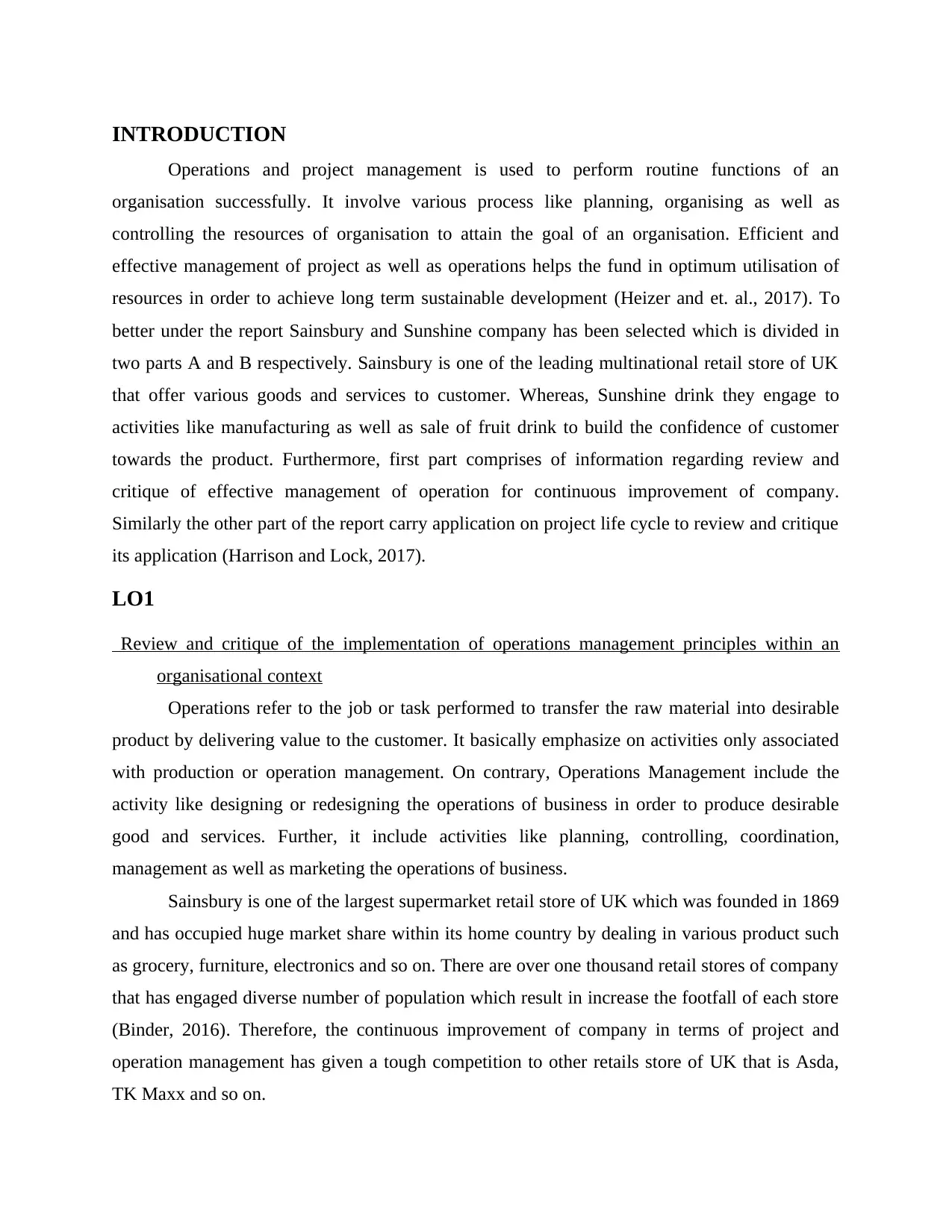
INTRODUCTION
Operations and project management is used to perform routine functions of an
organisation successfully. It involve various process like planning, organising as well as
controlling the resources of organisation to attain the goal of an organisation. Efficient and
effective management of project as well as operations helps the fund in optimum utilisation of
resources in order to achieve long term sustainable development (Heizer and et. al., 2017). To
better under the report Sainsbury and Sunshine company has been selected which is divided in
two parts A and B respectively. Sainsbury is one of the leading multinational retail store of UK
that offer various goods and services to customer. Whereas, Sunshine drink they engage to
activities like manufacturing as well as sale of fruit drink to build the confidence of customer
towards the product. Furthermore, first part comprises of information regarding review and
critique of effective management of operation for continuous improvement of company.
Similarly the other part of the report carry application on project life cycle to review and critique
its application (Harrison and Lock, 2017).
LO1
Review and critique of the implementation of operations management principles within an
organisational context
Operations refer to the job or task performed to transfer the raw material into desirable
product by delivering value to the customer. It basically emphasize on activities only associated
with production or operation management. On contrary, Operations Management include the
activity like designing or redesigning the operations of business in order to produce desirable
good and services. Further, it include activities like planning, controlling, coordination,
management as well as marketing the operations of business.
Sainsbury is one of the largest supermarket retail store of UK which was founded in 1869
and has occupied huge market share within its home country by dealing in various product such
as grocery, furniture, electronics and so on. There are over one thousand retail stores of company
that has engaged diverse number of population which result in increase the footfall of each store
(Binder, 2016). Therefore, the continuous improvement of company in terms of project and
operation management has given a tough competition to other retails store of UK that is Asda,
TK Maxx and so on.
Operations and project management is used to perform routine functions of an
organisation successfully. It involve various process like planning, organising as well as
controlling the resources of organisation to attain the goal of an organisation. Efficient and
effective management of project as well as operations helps the fund in optimum utilisation of
resources in order to achieve long term sustainable development (Heizer and et. al., 2017). To
better under the report Sainsbury and Sunshine company has been selected which is divided in
two parts A and B respectively. Sainsbury is one of the leading multinational retail store of UK
that offer various goods and services to customer. Whereas, Sunshine drink they engage to
activities like manufacturing as well as sale of fruit drink to build the confidence of customer
towards the product. Furthermore, first part comprises of information regarding review and
critique of effective management of operation for continuous improvement of company.
Similarly the other part of the report carry application on project life cycle to review and critique
its application (Harrison and Lock, 2017).
LO1
Review and critique of the implementation of operations management principles within an
organisational context
Operations refer to the job or task performed to transfer the raw material into desirable
product by delivering value to the customer. It basically emphasize on activities only associated
with production or operation management. On contrary, Operations Management include the
activity like designing or redesigning the operations of business in order to produce desirable
good and services. Further, it include activities like planning, controlling, coordination,
management as well as marketing the operations of business.
Sainsbury is one of the largest supermarket retail store of UK which was founded in 1869
and has occupied huge market share within its home country by dealing in various product such
as grocery, furniture, electronics and so on. There are over one thousand retail stores of company
that has engaged diverse number of population which result in increase the footfall of each store
(Binder, 2016). Therefore, the continuous improvement of company in terms of project and
operation management has given a tough competition to other retails store of UK that is Asda,
TK Maxx and so on.
⊘ This is a preview!⊘
Do you want full access?
Subscribe today to unlock all pages.

Trusted by 1+ million students worldwide
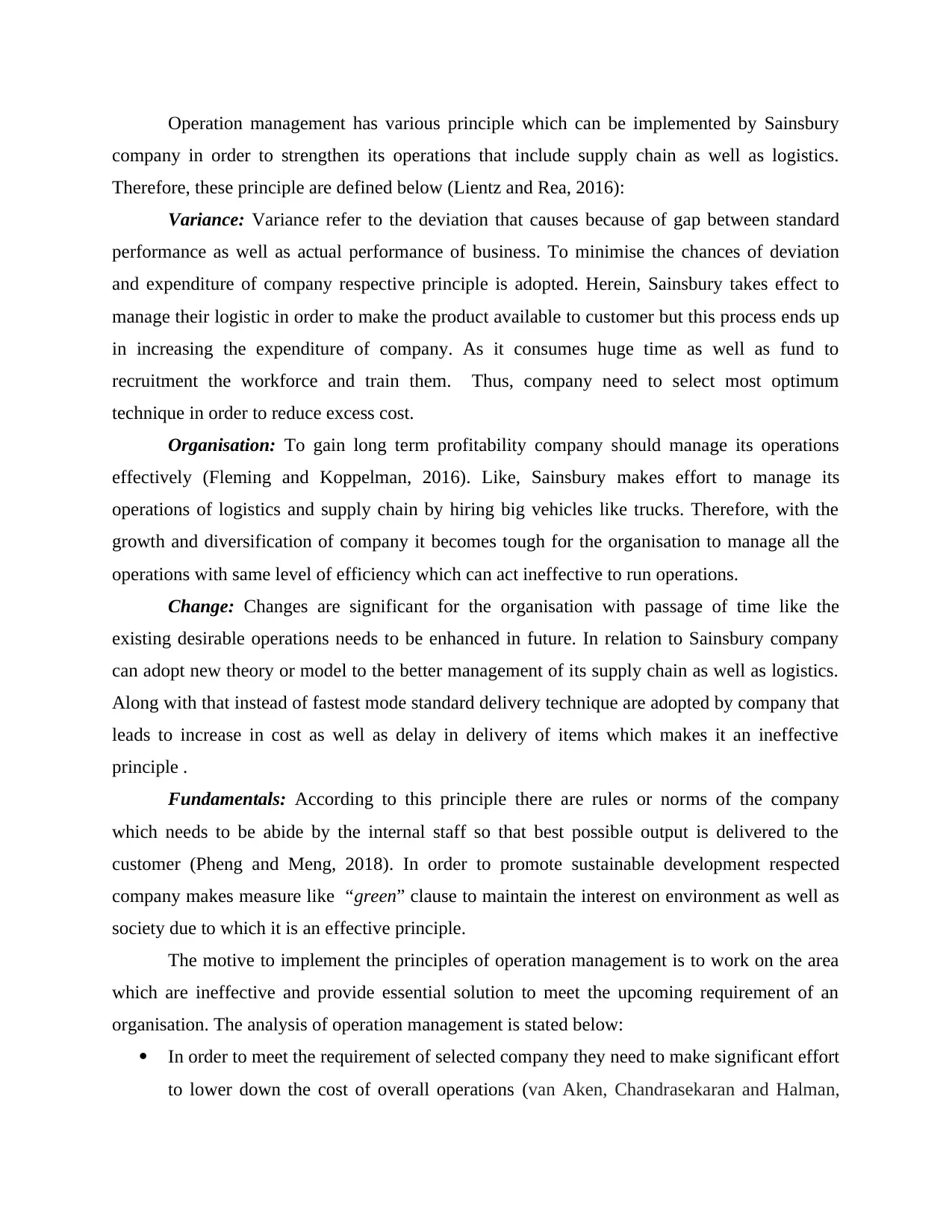
Operation management has various principle which can be implemented by Sainsbury
company in order to strengthen its operations that include supply chain as well as logistics.
Therefore, these principle are defined below (Lientz and Rea, 2016):
Variance: Variance refer to the deviation that causes because of gap between standard
performance as well as actual performance of business. To minimise the chances of deviation
and expenditure of company respective principle is adopted. Herein, Sainsbury takes effect to
manage their logistic in order to make the product available to customer but this process ends up
in increasing the expenditure of company. As it consumes huge time as well as fund to
recruitment the workforce and train them. Thus, company need to select most optimum
technique in order to reduce excess cost.
Organisation: To gain long term profitability company should manage its operations
effectively (Fleming and Koppelman, 2016). Like, Sainsbury makes effort to manage its
operations of logistics and supply chain by hiring big vehicles like trucks. Therefore, with the
growth and diversification of company it becomes tough for the organisation to manage all the
operations with same level of efficiency which can act ineffective to run operations.
Change: Changes are significant for the organisation with passage of time like the
existing desirable operations needs to be enhanced in future. In relation to Sainsbury company
can adopt new theory or model to the better management of its supply chain as well as logistics.
Along with that instead of fastest mode standard delivery technique are adopted by company that
leads to increase in cost as well as delay in delivery of items which makes it an ineffective
principle .
Fundamentals: According to this principle there are rules or norms of the company
which needs to be abide by the internal staff so that best possible output is delivered to the
customer (Pheng and Meng, 2018). In order to promote sustainable development respected
company makes measure like “green” clause to maintain the interest on environment as well as
society due to which it is an effective principle.
The motive to implement the principles of operation management is to work on the area
which are ineffective and provide essential solution to meet the upcoming requirement of an
organisation. The analysis of operation management is stated below:
In order to meet the requirement of selected company they need to make significant effort
to lower down the cost of overall operations (van Aken, Chandrasekaran and Halman,
company in order to strengthen its operations that include supply chain as well as logistics.
Therefore, these principle are defined below (Lientz and Rea, 2016):
Variance: Variance refer to the deviation that causes because of gap between standard
performance as well as actual performance of business. To minimise the chances of deviation
and expenditure of company respective principle is adopted. Herein, Sainsbury takes effect to
manage their logistic in order to make the product available to customer but this process ends up
in increasing the expenditure of company. As it consumes huge time as well as fund to
recruitment the workforce and train them. Thus, company need to select most optimum
technique in order to reduce excess cost.
Organisation: To gain long term profitability company should manage its operations
effectively (Fleming and Koppelman, 2016). Like, Sainsbury makes effort to manage its
operations of logistics and supply chain by hiring big vehicles like trucks. Therefore, with the
growth and diversification of company it becomes tough for the organisation to manage all the
operations with same level of efficiency which can act ineffective to run operations.
Change: Changes are significant for the organisation with passage of time like the
existing desirable operations needs to be enhanced in future. In relation to Sainsbury company
can adopt new theory or model to the better management of its supply chain as well as logistics.
Along with that instead of fastest mode standard delivery technique are adopted by company that
leads to increase in cost as well as delay in delivery of items which makes it an ineffective
principle .
Fundamentals: According to this principle there are rules or norms of the company
which needs to be abide by the internal staff so that best possible output is delivered to the
customer (Pheng and Meng, 2018). In order to promote sustainable development respected
company makes measure like “green” clause to maintain the interest on environment as well as
society due to which it is an effective principle.
The motive to implement the principles of operation management is to work on the area
which are ineffective and provide essential solution to meet the upcoming requirement of an
organisation. The analysis of operation management is stated below:
In order to meet the requirement of selected company they need to make significant effort
to lower down the cost of overall operations (van Aken, Chandrasekaran and Halman,
Paraphrase This Document
Need a fresh take? Get an instant paraphrase of this document with our AI Paraphraser
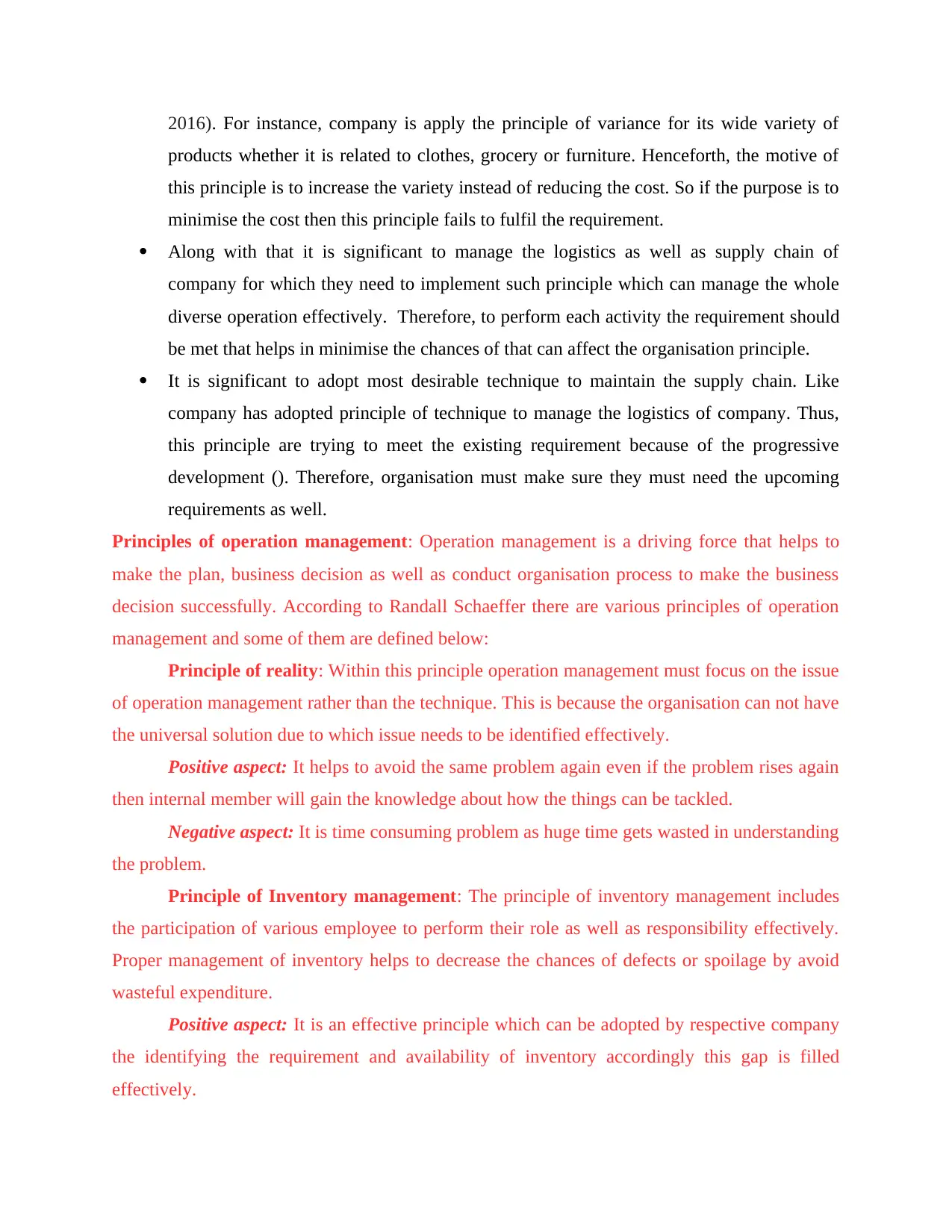
2016). For instance, company is apply the principle of variance for its wide variety of
products whether it is related to clothes, grocery or furniture. Henceforth, the motive of
this principle is to increase the variety instead of reducing the cost. So if the purpose is to
minimise the cost then this principle fails to fulfil the requirement.
Along with that it is significant to manage the logistics as well as supply chain of
company for which they need to implement such principle which can manage the whole
diverse operation effectively. Therefore, to perform each activity the requirement should
be met that helps in minimise the chances of that can affect the organisation principle.
It is significant to adopt most desirable technique to maintain the supply chain. Like
company has adopted principle of technique to manage the logistics of company. Thus,
this principle are trying to meet the existing requirement because of the progressive
development (). Therefore, organisation must make sure they must need the upcoming
requirements as well.
Principles of operation management: Operation management is a driving force that helps to
make the plan, business decision as well as conduct organisation process to make the business
decision successfully. According to Randall Schaeffer there are various principles of operation
management and some of them are defined below:
Principle of reality: Within this principle operation management must focus on the issue
of operation management rather than the technique. This is because the organisation can not have
the universal solution due to which issue needs to be identified effectively.
Positive aspect: It helps to avoid the same problem again even if the problem rises again
then internal member will gain the knowledge about how the things can be tackled.
Negative aspect: It is time consuming problem as huge time gets wasted in understanding
the problem.
Principle of Inventory management: The principle of inventory management includes
the participation of various employee to perform their role as well as responsibility effectively.
Proper management of inventory helps to decrease the chances of defects or spoilage by avoid
wasteful expenditure.
Positive aspect: It is an effective principle which can be adopted by respective company
the identifying the requirement and availability of inventory accordingly this gap is filled
effectively.
products whether it is related to clothes, grocery or furniture. Henceforth, the motive of
this principle is to increase the variety instead of reducing the cost. So if the purpose is to
minimise the cost then this principle fails to fulfil the requirement.
Along with that it is significant to manage the logistics as well as supply chain of
company for which they need to implement such principle which can manage the whole
diverse operation effectively. Therefore, to perform each activity the requirement should
be met that helps in minimise the chances of that can affect the organisation principle.
It is significant to adopt most desirable technique to maintain the supply chain. Like
company has adopted principle of technique to manage the logistics of company. Thus,
this principle are trying to meet the existing requirement because of the progressive
development (). Therefore, organisation must make sure they must need the upcoming
requirements as well.
Principles of operation management: Operation management is a driving force that helps to
make the plan, business decision as well as conduct organisation process to make the business
decision successfully. According to Randall Schaeffer there are various principles of operation
management and some of them are defined below:
Principle of reality: Within this principle operation management must focus on the issue
of operation management rather than the technique. This is because the organisation can not have
the universal solution due to which issue needs to be identified effectively.
Positive aspect: It helps to avoid the same problem again even if the problem rises again
then internal member will gain the knowledge about how the things can be tackled.
Negative aspect: It is time consuming problem as huge time gets wasted in understanding
the problem.
Principle of Inventory management: The principle of inventory management includes
the participation of various employee to perform their role as well as responsibility effectively.
Proper management of inventory helps to decrease the chances of defects or spoilage by avoid
wasteful expenditure.
Positive aspect: It is an effective principle which can be adopted by respective company
the identifying the requirement and availability of inventory accordingly this gap is filled
effectively.
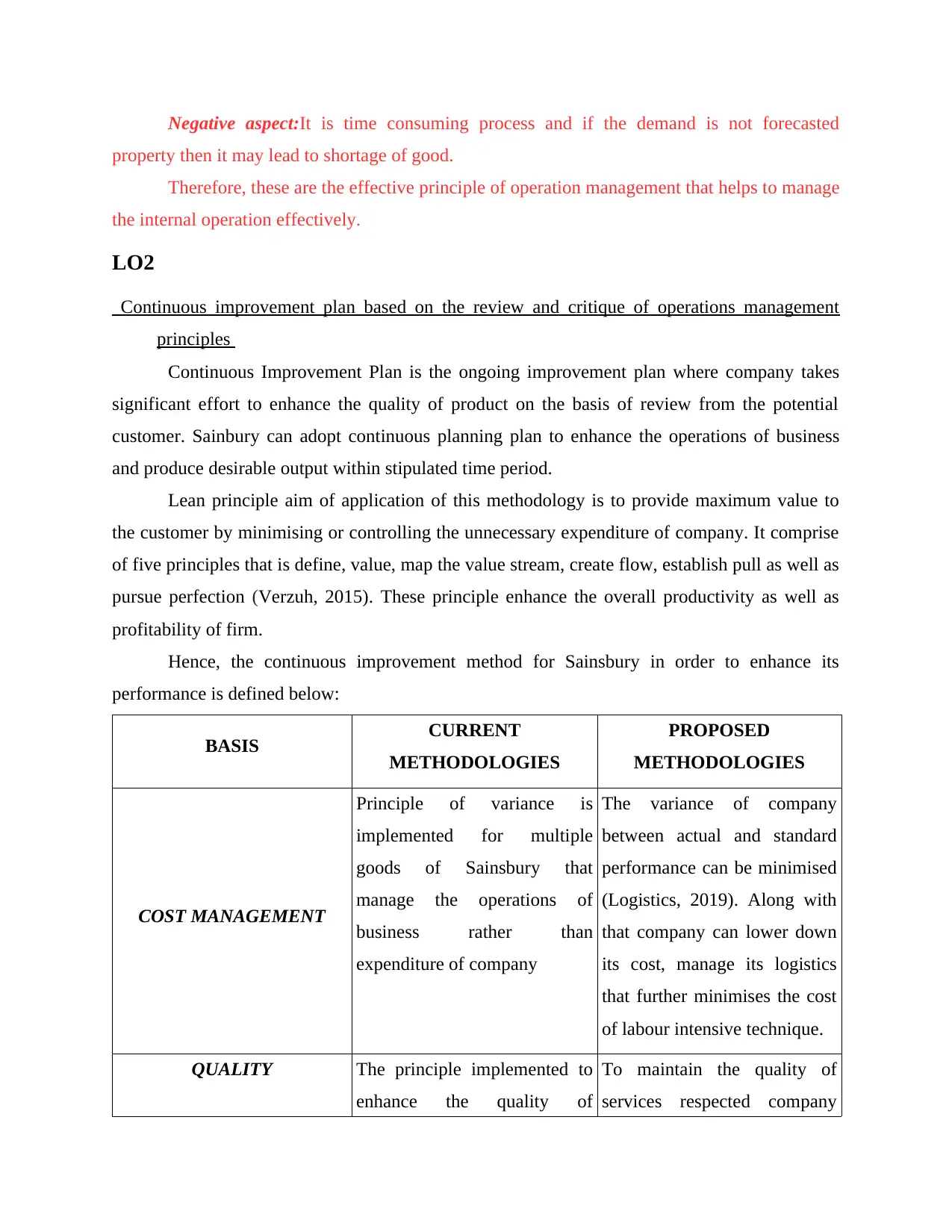
Negative aspect:It is time consuming process and if the demand is not forecasted
property then it may lead to shortage of good.
Therefore, these are the effective principle of operation management that helps to manage
the internal operation effectively.
LO2
Continuous improvement plan based on the review and critique of operations management
principles
Continuous Improvement Plan is the ongoing improvement plan where company takes
significant effort to enhance the quality of product on the basis of review from the potential
customer. Sainbury can adopt continuous planning plan to enhance the operations of business
and produce desirable output within stipulated time period.
Lean principle aim of application of this methodology is to provide maximum value to
the customer by minimising or controlling the unnecessary expenditure of company. It comprise
of five principles that is define, value, map the value stream, create flow, establish pull as well as
pursue perfection (Verzuh, 2015). These principle enhance the overall productivity as well as
profitability of firm.
Hence, the continuous improvement method for Sainsbury in order to enhance its
performance is defined below:
BASIS CURRENT
METHODOLOGIES
PROPOSED
METHODOLOGIES
COST MANAGEMENT
Principle of variance is
implemented for multiple
goods of Sainsbury that
manage the operations of
business rather than
expenditure of company
The variance of company
between actual and standard
performance can be minimised
(Logistics, 2019). Along with
that company can lower down
its cost, manage its logistics
that further minimises the cost
of labour intensive technique.
QUALITY The principle implemented to
enhance the quality of
To maintain the quality of
services respected company
property then it may lead to shortage of good.
Therefore, these are the effective principle of operation management that helps to manage
the internal operation effectively.
LO2
Continuous improvement plan based on the review and critique of operations management
principles
Continuous Improvement Plan is the ongoing improvement plan where company takes
significant effort to enhance the quality of product on the basis of review from the potential
customer. Sainbury can adopt continuous planning plan to enhance the operations of business
and produce desirable output within stipulated time period.
Lean principle aim of application of this methodology is to provide maximum value to
the customer by minimising or controlling the unnecessary expenditure of company. It comprise
of five principles that is define, value, map the value stream, create flow, establish pull as well as
pursue perfection (Verzuh, 2015). These principle enhance the overall productivity as well as
profitability of firm.
Hence, the continuous improvement method for Sainsbury in order to enhance its
performance is defined below:
BASIS CURRENT
METHODOLOGIES
PROPOSED
METHODOLOGIES
COST MANAGEMENT
Principle of variance is
implemented for multiple
goods of Sainsbury that
manage the operations of
business rather than
expenditure of company
The variance of company
between actual and standard
performance can be minimised
(Logistics, 2019). Along with
that company can lower down
its cost, manage its logistics
that further minimises the cost
of labour intensive technique.
QUALITY The principle implemented to
enhance the quality of
To maintain the quality of
services respected company
⊘ This is a preview!⊘
Do you want full access?
Subscribe today to unlock all pages.

Trusted by 1+ million students worldwide
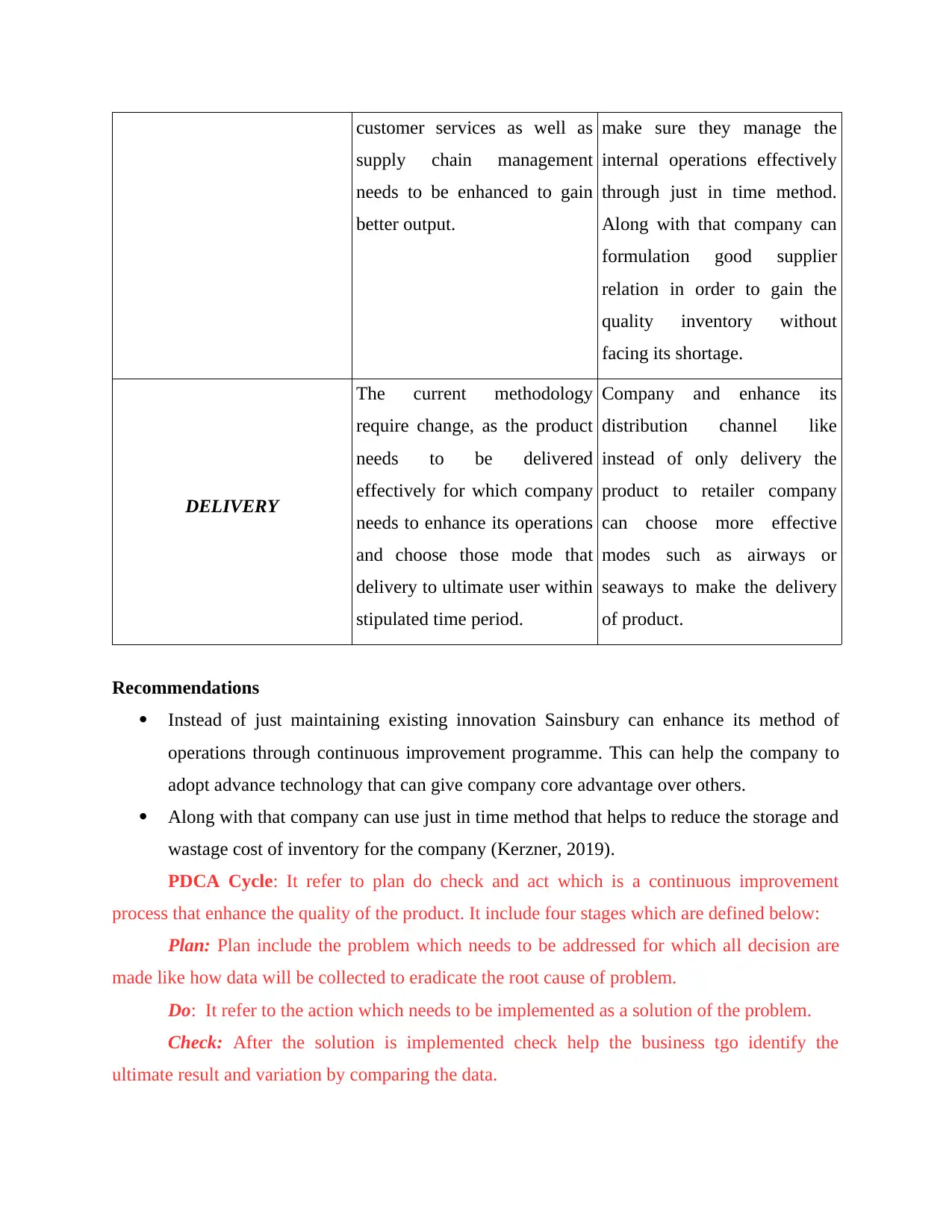
customer services as well as
supply chain management
needs to be enhanced to gain
better output.
make sure they manage the
internal operations effectively
through just in time method.
Along with that company can
formulation good supplier
relation in order to gain the
quality inventory without
facing its shortage.
DELIVERY
The current methodology
require change, as the product
needs to be delivered
effectively for which company
needs to enhance its operations
and choose those mode that
delivery to ultimate user within
stipulated time period.
Company and enhance its
distribution channel like
instead of only delivery the
product to retailer company
can choose more effective
modes such as airways or
seaways to make the delivery
of product.
Recommendations
Instead of just maintaining existing innovation Sainsbury can enhance its method of
operations through continuous improvement programme. This can help the company to
adopt advance technology that can give company core advantage over others.
Along with that company can use just in time method that helps to reduce the storage and
wastage cost of inventory for the company (Kerzner, 2019).
PDCA Cycle: It refer to plan do check and act which is a continuous improvement
process that enhance the quality of the product. It include four stages which are defined below:
Plan: Plan include the problem which needs to be addressed for which all decision are
made like how data will be collected to eradicate the root cause of problem.
Do: It refer to the action which needs to be implemented as a solution of the problem.
Check: After the solution is implemented check help the business tgo identify the
ultimate result and variation by comparing the data.
supply chain management
needs to be enhanced to gain
better output.
make sure they manage the
internal operations effectively
through just in time method.
Along with that company can
formulation good supplier
relation in order to gain the
quality inventory without
facing its shortage.
DELIVERY
The current methodology
require change, as the product
needs to be delivered
effectively for which company
needs to enhance its operations
and choose those mode that
delivery to ultimate user within
stipulated time period.
Company and enhance its
distribution channel like
instead of only delivery the
product to retailer company
can choose more effective
modes such as airways or
seaways to make the delivery
of product.
Recommendations
Instead of just maintaining existing innovation Sainsbury can enhance its method of
operations through continuous improvement programme. This can help the company to
adopt advance technology that can give company core advantage over others.
Along with that company can use just in time method that helps to reduce the storage and
wastage cost of inventory for the company (Kerzner, 2019).
PDCA Cycle: It refer to plan do check and act which is a continuous improvement
process that enhance the quality of the product. It include four stages which are defined below:
Plan: Plan include the problem which needs to be addressed for which all decision are
made like how data will be collected to eradicate the root cause of problem.
Do: It refer to the action which needs to be implemented as a solution of the problem.
Check: After the solution is implemented check help the business tgo identify the
ultimate result and variation by comparing the data.
Paraphrase This Document
Need a fresh take? Get an instant paraphrase of this document with our AI Paraphraser
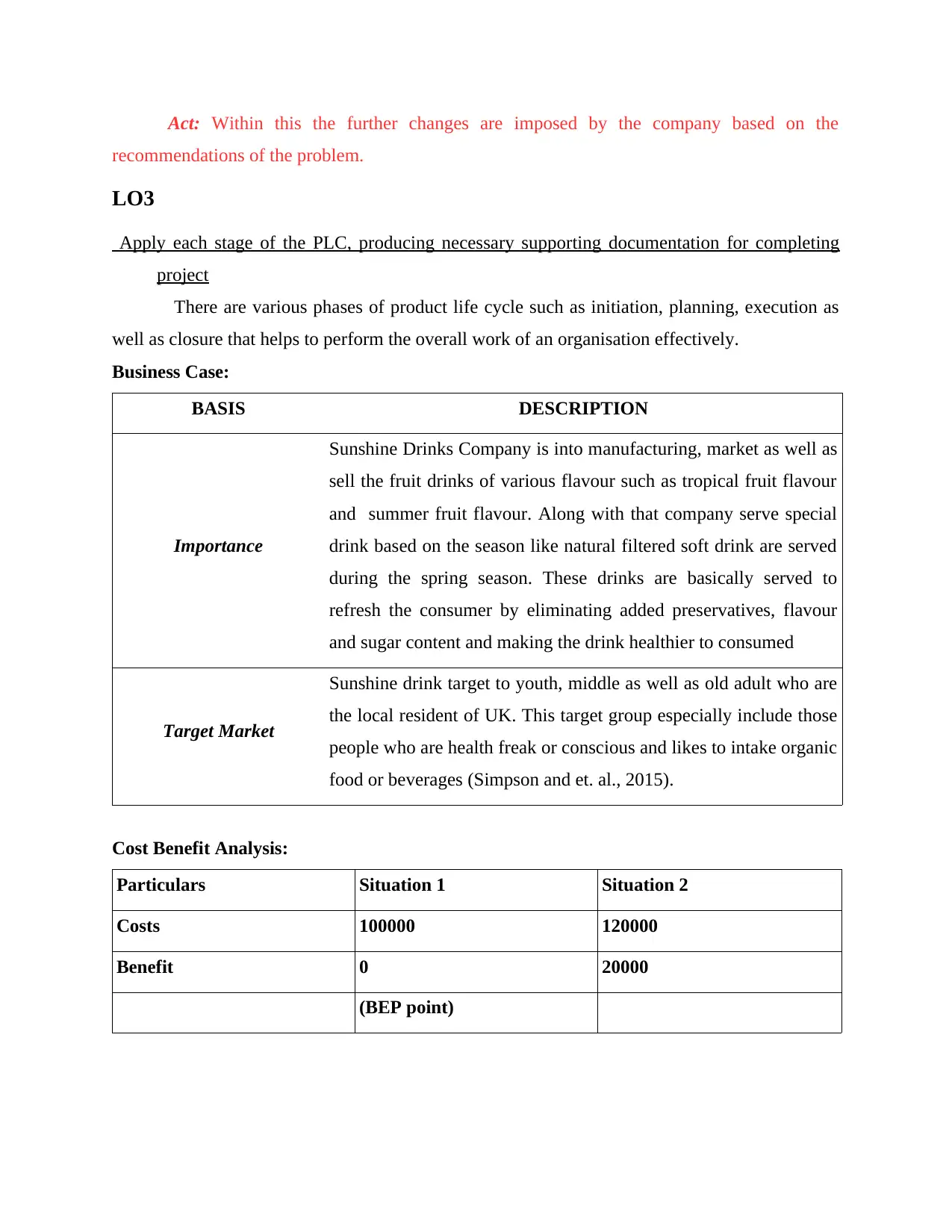
Act: Within this the further changes are imposed by the company based on the
recommendations of the problem.
LO3
Apply each stage of the PLC, producing necessary supporting documentation for completing
project
There are various phases of product life cycle such as initiation, planning, execution as
well as closure that helps to perform the overall work of an organisation effectively.
Business Case:
BASIS DESCRIPTION
Importance
Sunshine Drinks Company is into manufacturing, market as well as
sell the fruit drinks of various flavour such as tropical fruit flavour
and summer fruit flavour. Along with that company serve special
drink based on the season like natural filtered soft drink are served
during the spring season. These drinks are basically served to
refresh the consumer by eliminating added preservatives, flavour
and sugar content and making the drink healthier to consumed
Target Market
Sunshine drink target to youth, middle as well as old adult who are
the local resident of UK. This target group especially include those
people who are health freak or conscious and likes to intake organic
food or beverages (Simpson and et. al., 2015).
Cost Benefit Analysis:
Particulars Situation 1 Situation 2
Costs 100000 120000
Benefit 0 20000
(BEP point)
recommendations of the problem.
LO3
Apply each stage of the PLC, producing necessary supporting documentation for completing
project
There are various phases of product life cycle such as initiation, planning, execution as
well as closure that helps to perform the overall work of an organisation effectively.
Business Case:
BASIS DESCRIPTION
Importance
Sunshine Drinks Company is into manufacturing, market as well as
sell the fruit drinks of various flavour such as tropical fruit flavour
and summer fruit flavour. Along with that company serve special
drink based on the season like natural filtered soft drink are served
during the spring season. These drinks are basically served to
refresh the consumer by eliminating added preservatives, flavour
and sugar content and making the drink healthier to consumed
Target Market
Sunshine drink target to youth, middle as well as old adult who are
the local resident of UK. This target group especially include those
people who are health freak or conscious and likes to intake organic
food or beverages (Simpson and et. al., 2015).
Cost Benefit Analysis:
Particulars Situation 1 Situation 2
Costs 100000 120000
Benefit 0 20000
(BEP point)
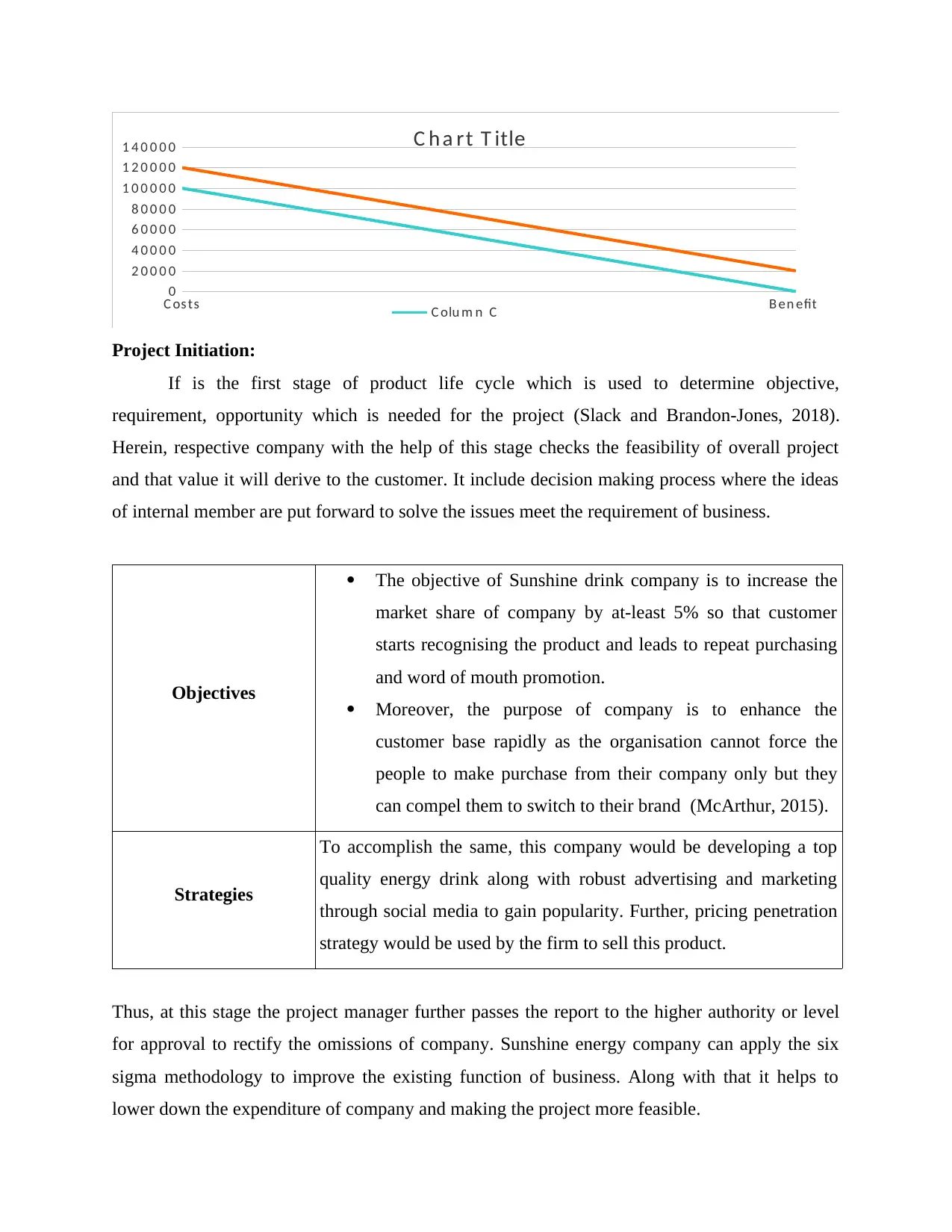
C os ts B en efit
0
2 0 0 0 0
4 0 0 0 0
6 0 0 0 0
8 0 0 0 0
1 0 0 0 0 0
1 2 0 0 0 0
1 4 0 0 0 0 C h a rt T itle
C olu m n C
Project Initiation:
If is the first stage of product life cycle which is used to determine objective,
requirement, opportunity which is needed for the project (Slack and Brandon-Jones, 2018).
Herein, respective company with the help of this stage checks the feasibility of overall project
and that value it will derive to the customer. It include decision making process where the ideas
of internal member are put forward to solve the issues meet the requirement of business.
Objectives
The objective of Sunshine drink company is to increase the
market share of company by at-least 5% so that customer
starts recognising the product and leads to repeat purchasing
and word of mouth promotion.
Moreover, the purpose of company is to enhance the
customer base rapidly as the organisation cannot force the
people to make purchase from their company only but they
can compel them to switch to their brand (McArthur, 2015).
Strategies
To accomplish the same, this company would be developing a top
quality energy drink along with robust advertising and marketing
through social media to gain popularity. Further, pricing penetration
strategy would be used by the firm to sell this product.
Thus, at this stage the project manager further passes the report to the higher authority or level
for approval to rectify the omissions of company. Sunshine energy company can apply the six
sigma methodology to improve the existing function of business. Along with that it helps to
lower down the expenditure of company and making the project more feasible.
0
2 0 0 0 0
4 0 0 0 0
6 0 0 0 0
8 0 0 0 0
1 0 0 0 0 0
1 2 0 0 0 0
1 4 0 0 0 0 C h a rt T itle
C olu m n C
Project Initiation:
If is the first stage of product life cycle which is used to determine objective,
requirement, opportunity which is needed for the project (Slack and Brandon-Jones, 2018).
Herein, respective company with the help of this stage checks the feasibility of overall project
and that value it will derive to the customer. It include decision making process where the ideas
of internal member are put forward to solve the issues meet the requirement of business.
Objectives
The objective of Sunshine drink company is to increase the
market share of company by at-least 5% so that customer
starts recognising the product and leads to repeat purchasing
and word of mouth promotion.
Moreover, the purpose of company is to enhance the
customer base rapidly as the organisation cannot force the
people to make purchase from their company only but they
can compel them to switch to their brand (McArthur, 2015).
Strategies
To accomplish the same, this company would be developing a top
quality energy drink along with robust advertising and marketing
through social media to gain popularity. Further, pricing penetration
strategy would be used by the firm to sell this product.
Thus, at this stage the project manager further passes the report to the higher authority or level
for approval to rectify the omissions of company. Sunshine energy company can apply the six
sigma methodology to improve the existing function of business. Along with that it helps to
lower down the expenditure of company and making the project more feasible.
⊘ This is a preview!⊘
Do you want full access?
Subscribe today to unlock all pages.

Trusted by 1+ million students worldwide
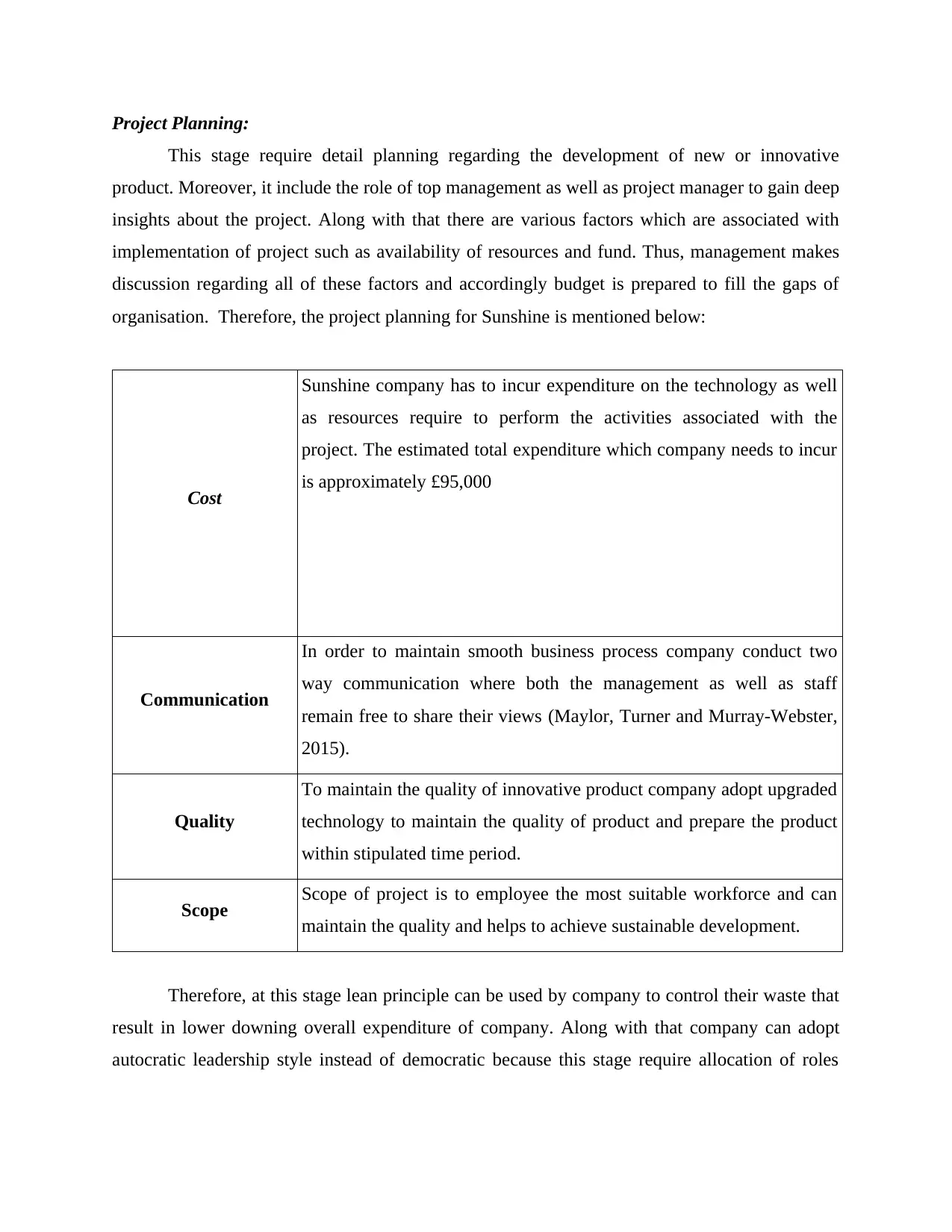
Project Planning:
This stage require detail planning regarding the development of new or innovative
product. Moreover, it include the role of top management as well as project manager to gain deep
insights about the project. Along with that there are various factors which are associated with
implementation of project such as availability of resources and fund. Thus, management makes
discussion regarding all of these factors and accordingly budget is prepared to fill the gaps of
organisation. Therefore, the project planning for Sunshine is mentioned below:
Cost
Sunshine company has to incur expenditure on the technology as well
as resources require to perform the activities associated with the
project. The estimated total expenditure which company needs to incur
is approximately £95,000
Communication
In order to maintain smooth business process company conduct two
way communication where both the management as well as staff
remain free to share their views (Maylor, Turner and Murray-Webster,
2015).
Quality
To maintain the quality of innovative product company adopt upgraded
technology to maintain the quality of product and prepare the product
within stipulated time period.
Scope Scope of project is to employee the most suitable workforce and can
maintain the quality and helps to achieve sustainable development.
Therefore, at this stage lean principle can be used by company to control their waste that
result in lower downing overall expenditure of company. Along with that company can adopt
autocratic leadership style instead of democratic because this stage require allocation of roles
This stage require detail planning regarding the development of new or innovative
product. Moreover, it include the role of top management as well as project manager to gain deep
insights about the project. Along with that there are various factors which are associated with
implementation of project such as availability of resources and fund. Thus, management makes
discussion regarding all of these factors and accordingly budget is prepared to fill the gaps of
organisation. Therefore, the project planning for Sunshine is mentioned below:
Cost
Sunshine company has to incur expenditure on the technology as well
as resources require to perform the activities associated with the
project. The estimated total expenditure which company needs to incur
is approximately £95,000
Communication
In order to maintain smooth business process company conduct two
way communication where both the management as well as staff
remain free to share their views (Maylor, Turner and Murray-Webster,
2015).
Quality
To maintain the quality of innovative product company adopt upgraded
technology to maintain the quality of product and prepare the product
within stipulated time period.
Scope Scope of project is to employee the most suitable workforce and can
maintain the quality and helps to achieve sustainable development.
Therefore, at this stage lean principle can be used by company to control their waste that
result in lower downing overall expenditure of company. Along with that company can adopt
autocratic leadership style instead of democratic because this stage require allocation of roles
Paraphrase This Document
Need a fresh take? Get an instant paraphrase of this document with our AI Paraphraser
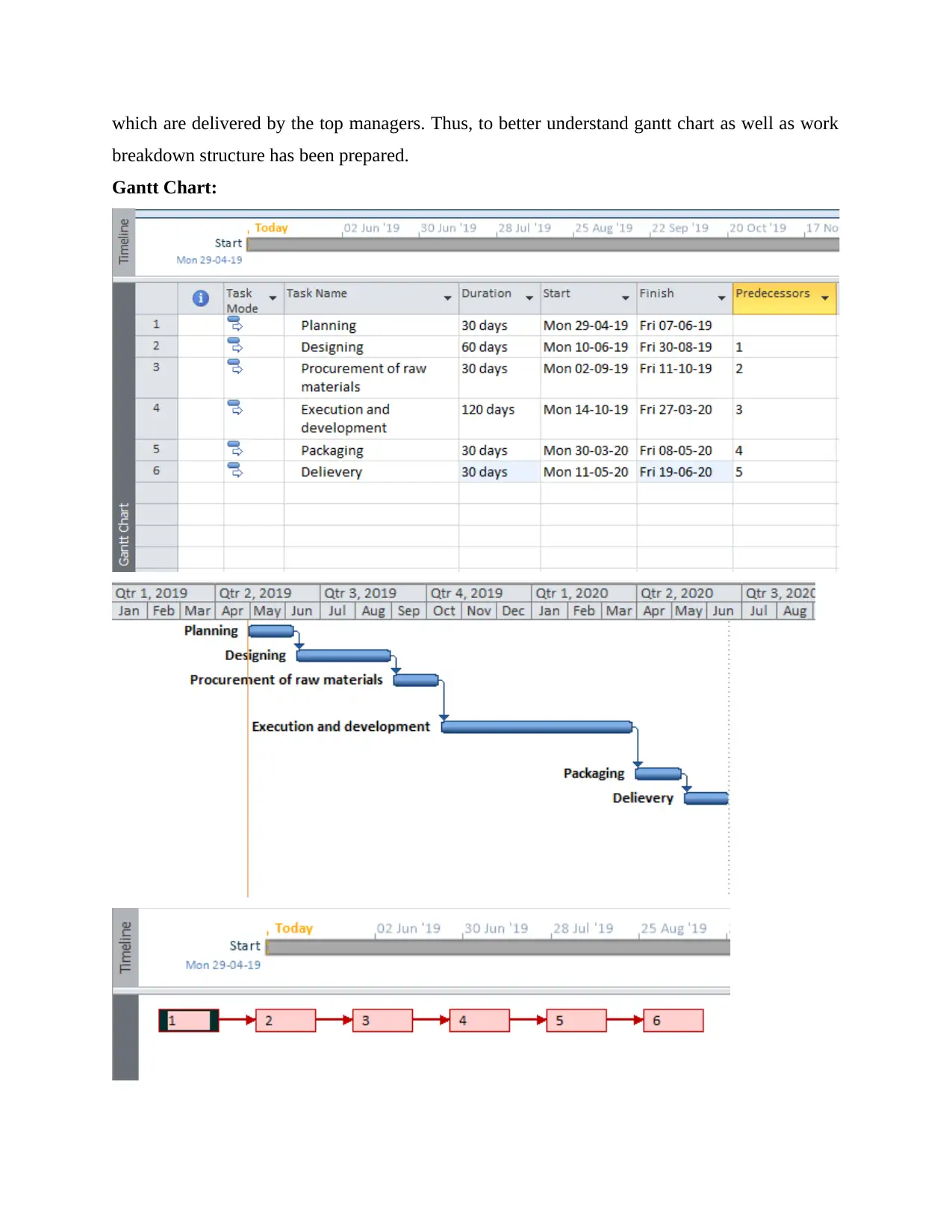
which are delivered by the top managers. Thus, to better understand gantt chart as well as work
breakdown structure has been prepared.
Gantt Chart:
breakdown structure has been prepared.
Gantt Chart:
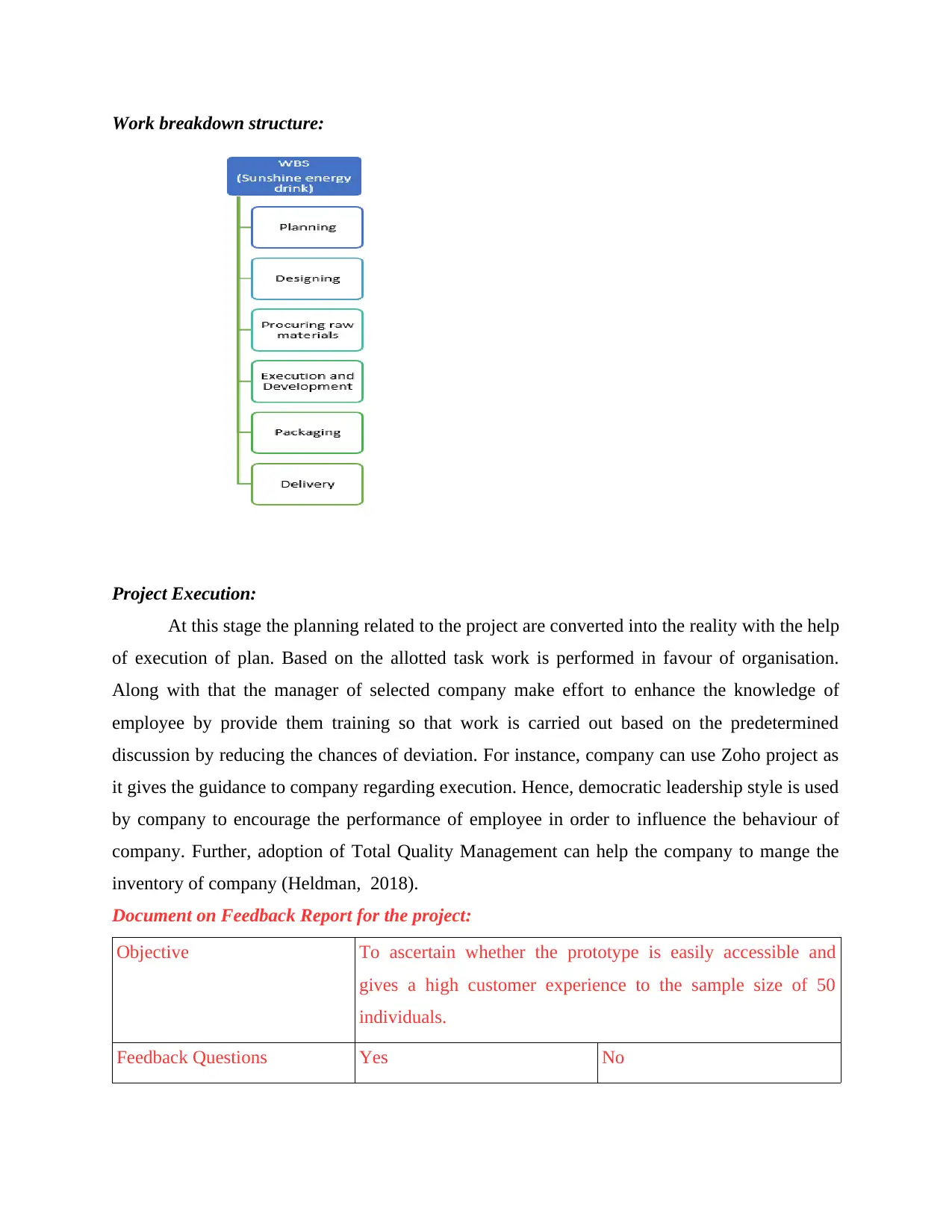
Work breakdown structure:
Project Execution:
At this stage the planning related to the project are converted into the reality with the help
of execution of plan. Based on the allotted task work is performed in favour of organisation.
Along with that the manager of selected company make effort to enhance the knowledge of
employee by provide them training so that work is carried out based on the predetermined
discussion by reducing the chances of deviation. For instance, company can use Zoho project as
it gives the guidance to company regarding execution. Hence, democratic leadership style is used
by company to encourage the performance of employee in order to influence the behaviour of
company. Further, adoption of Total Quality Management can help the company to mange the
inventory of company (Heldman, 2018).
Document on Feedback Report for the project:
Objective To ascertain whether the prototype is easily accessible and
gives a high customer experience to the sample size of 50
individuals.
Feedback Questions Yes No
Project Execution:
At this stage the planning related to the project are converted into the reality with the help
of execution of plan. Based on the allotted task work is performed in favour of organisation.
Along with that the manager of selected company make effort to enhance the knowledge of
employee by provide them training so that work is carried out based on the predetermined
discussion by reducing the chances of deviation. For instance, company can use Zoho project as
it gives the guidance to company regarding execution. Hence, democratic leadership style is used
by company to encourage the performance of employee in order to influence the behaviour of
company. Further, adoption of Total Quality Management can help the company to mange the
inventory of company (Heldman, 2018).
Document on Feedback Report for the project:
Objective To ascertain whether the prototype is easily accessible and
gives a high customer experience to the sample size of 50
individuals.
Feedback Questions Yes No
⊘ This is a preview!⊘
Do you want full access?
Subscribe today to unlock all pages.

Trusted by 1+ million students worldwide
1 out of 19
Related Documents
Your All-in-One AI-Powered Toolkit for Academic Success.
+13062052269
info@desklib.com
Available 24*7 on WhatsApp / Email
![[object Object]](/_next/static/media/star-bottom.7253800d.svg)
Unlock your academic potential
Copyright © 2020–2025 A2Z Services. All Rights Reserved. Developed and managed by ZUCOL.



